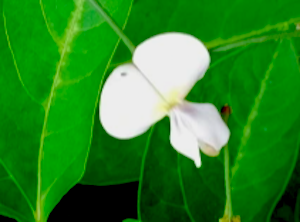Tropical Garden Grow Guide
Where you are the student and the teacher

 Black Eyed Peas
Flower
Black Eyed Peas
FlowerBlack Eyed Peas
(Submitted by Mary Loan)
Botanic
name:
Vinga unguiculta; a
sub species of the cow pea and a member of the Fabaceae
bean
family
Plant type and
history: Black
eyed
peas are a leguminous vine or bush bean
plant. The
peas are ivory colored each one in the
pod has distinctive small black mark.
The origin of the plant traces back to West
Africa, then to India and
China, then world-wide to regions that allow for at
least 100 frost-free days
from planting the seeds until harvest.
Black-eyed peas were introduced to the
Americas by African slaves.
Sun exposure: At
least
8 hours of sun each day. Will
tolerate some afternoon shade.
pH: Grows
best in soil with a
pH between 5.5 and 6.5.
Soil preference: Black-eyed
peas will grow
in many kinds of soil, but are most productive in
sandy, loamy, well-draining
soil; they do not grow well in soggy growing
conditions.
How to grow: Black-eyed
peas are easy to
grow. They
thrive in high heat and
humidity and are drought-resistant.
Seeds are easily available at the San Ignacio
open air market at market
stalls. Please
note: there are two
varieties of black-eyed pea seeds. One
grows to be a climbing vine, the other a bush.
Unless you are handy with building a trellis
or setting in tall poles
for support, it is best to plant the bush variety.
(The seeds I planted from
the bag of seeds I purchased at the San Ignacio
market and planted are not yet
tall enough to know if they are bush or vines).
Farmer/author Deborah Harder
recommends planting black-eyed peas in the summer to
be eaten as tender pods
before summer's end, then left to grow until the
pods are crisp and dry and the
seeds are developed and ready for harvest.
Cultivate the soil, smooth over and plant the
seeds about ¾ inches deep,
approximately 2 inches apart and water each day
until the first leaves appear
in around 5 days, then thin plants to be 4 inches
apart. Plants
require minimal irrigation once they
are up and growing.
Disease and insect
control:
Black-eyed
peas
are a hardy plant, resistant to disease and insects. Powdery
mildew may appear on the leaves due
to crowded plants and high humidity; to avoid, water
plants only in the morning
and weed around the plants and thin if necessary to
allow air to circulate. If
aphids appear it is recommended to blast them off
with your garden hose.
Diluted neem oil or organic insecticide soap
may be used to avert leaf hoppers. To
avoid root knot nematodes be sure to rotate crops
from harvest to harvest. The
strong scent of basil planted close by will also
repel many insects.
To harvest: While
you
are waiting 100 days for the pea pods to be ready to
harvest, you can enjoy
some of the tender leaves or some small green pods
steamed or stir fried.
The peas are ready for harvest when the
pods are dry and brittle. Remove the
peas and allow to dry completely then dry and store
in a glass jar out of the
rays of the sun or store in a container in your
freezer.
Health benefits: Black-eyed
peas are nutrient dense. They are a
good source of folate, thiamine,
iron, magnesium, manganese, phosphorous, zinc and
fiber. The
plants enrich the soil they are planted
in.
Recipe: Black-eyed
peas are adaptable to many bean
recipes. One
of the all-time favorite
recipes is Hoppin' John, which has become part of
the New Years day celebration
for some black cultures to welcome good luck in the
new year. There
are many recipes for Hoppin' John. Here is
one of them: You can be creative with
the ingredients.
Hoppin' John
2
cups dried black-eyed
peas sorted and rinsed
6
cups water, plus a cup or
so more as needed (you can use 5 cups if you are not
adding rice)
½
tsp. dried oregano or 1
tsp. minced fresh oregano
½ tsp. thyme
of 1 tsp. minced fresh thyme
1
bay leaf
1
cup diced onion
2
cloves minced garlic
1
cup diced tomatoes
½
cup chopped green pepper
1
cup sliced okra
(optional)
1
cup brown rice (optional)
1
shredded cup fresh greens
(chaya, kale, bok choy)
salt,
pepper and hot sauce
to taste
Place
all ingredients in a
large pot, bring to a boil, cover, reduce heat and
cook for about 40 minutes,
or until the black-eyed peas are soft.
Add water and stir as needed to prevent
ingredients from sticking to the
bottom of the pot.
Black-eyed
peas produce an
abundance of pink, purple, white and yellow flowers.
They are favorites of the
bees who collect nectar and make honey.
Black-eyed
peas are easy to
sprout. Place
1 cup of peas in a glass
jar rinse well and drain, then add 2 cups of water
and allow to soak
overnight. The
next morning rinse and drain
the peas and place the jar in a cool as possible
dark space (not your
refrigerator).
In about two days tiny
sprouts will appear.
By day three, the
sprouts will be ready to enjoy in salads, sandwiches
etc. They
can then be placed in your fridge and
will be fine to eat for about one week.
